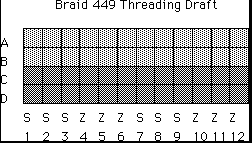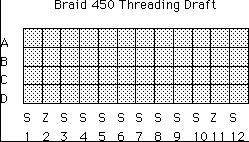

This document is provided as is without any express or implied warranties. While every effort has been taken to ensure the accuracy of the information contained, the author assumes no responsibility for errors or omissions, or for damages resulting from the use of the information contained herein.
Permission is granted to make and distribute verbatim copies of this document for non-commercial private research purposes provided the copyright notice and this permission notice are preserved on all copies.
This document was originally submitted to the December 1995 Arts and Sciences issue of Pikestaff, the newsletter of the East Kingdom, Society for Creative Anachronism, Inc. That issue has not yet been published.
Copyright © 1995, Carolyn Priest-Dorman.
This article gives recipes for three tablet weaving techniques that have been dated to fourteenth- and fifteenth-century England. They are based on analyses made by Elisabeth Crowfoot of Braids 449, 450, and 423 catalogued in the Museum of London (see below for citation). Depending on the size of thread or yarn you use, these recipes can produce impressive hair fillets, belts, baldrics, spur straps, ribbons, and the like.
To make use of this article, you must already have some basic knowledge of the mechanics and terminology of tablet-weaving. You should have completed at least one tablet-weaving project and want to know more about SCA period techniques of tablet-weaving. You should already know how to read a tablet-weaving draft, number your tablets, correctly thread the tablets S- or Z-wise as needed, warp whatever kind of loom you use based on the draft, follow a turning sequence, and remove the piece from the loom. It is also assumed that you thread your tablets with the printed side toward the right, with Tablet 1 at the left side of the pack.
Match your yarn to the texture you are trying to achieve. If you want a smooth, glossy surface, tightly-plied silk or linen is going to work better than loosely-plied wool. If you want a solid, compact surface, wool will serve best. Cotton is less glossy than silk or linen, and there's no evidence yet that it was used for medieval tablet-weaving in England, but it still makes for durable field wear, and some cotton yarns are machine washable.
The recipes given below rely on the use of "warp-twined selvedges" to provide firmness and strength at the edges of the woven piece. They are simply edges executed in plain weave (i.e., four-hole threading and continuous forward turning) irrespective of the technique used for the rest of the weaving. Warp-twined selvedges were an important component of a carefully woven piece in the Middle Ages. Marking or coloring the edges of the tablets used for the selvedges helps make it quick and easy to identify them during the weaving of a piece.
If you double-check your threading before you start to weave, it will probably save you some big headaches. It shouldn't take you more than a minute to thumb through the pack and make sure that each tablet is threaded in the correct direction (S-wise or Z-wise). If you're weaving the two-color braid, check also to make sure that your two colors of yarn are in the correct holes.
All the threading diagrams and turning sequences in this article are predicated on the initial placement of the tablets in a "home position." The term "home position," borrowed from the book Step by Step Tablet Weaving, refers to the basic starting point of a sequence of weaving. In this case, it refers to the position of the tablets wherein all the tablets have holes C and D placed closest to the fell (woven part of the piece, as opposed to the as-yet-unwoven part, or warp). In this position holes A and B are closest to the warp. Thus, holes A and D are "up." If you try to use recipes from other commercial instruction or draft books, such as Candace Crockett's or Russell Groff's patterns, it is important to be aware that not all of them rely on this particular interpretation of "home position." Russell Groff's pattern drafts, for example, require beginning with holes A and D closest to the fell. But for our purposes you should set up all your tablets with holes A and D "up."
The original of this piece was woven of silk in two colors, pink and yellow (or white). It was 8.5mm wide, had bronze bar mounts riveted to it, and may have been used as a girdle or spur strap (Crowfoot et al., 133). This recipe will weave up more pleasingly if finer yarns are used. It might make an interesting boldly striped belt if thicker yarns are used, or more cards are added.

Set up your warp as in the threading diagram labeled "Braid 449." If you want to make your piece wider than 12 tablets, you can do so easily. Simply warp up as many extra tablets in groups of three as you like, making sure that each group of three is threaded in the opposite direction from the previous group of three.
Turn the entire pack continuously forward. If you need to, reverse and turn the whole pack backwards; there is an example of exactly this reversal in the original braid. Also, the original seems to have been woven with a fairly heavy beat.
The original ribbon was threaded with four strands of silk yarn through each hole, which gave a fat, soft, cushiony braid; it may have been used as a girdle or spur strap (Crowfoot et al., 133). You can do the same if you want a really soft effect: silk two-ply embroidery floss would be particularly nice. Otherwise, just about any kind of yarn or thread will work: wool, linen, or silk are especially appropriate.

Set up your warp as in the threading diagram labeled "Braid 450."
Separate the tablets into three packs. Pack I is tablets 1-2 and 11-12. Pack II is all the remaining odd-numbered tablets (3, 5, 7, and 9). Pack III is all the remaining even-numbered tablets (4, 6, 8, and 10).
Turn the cards in the following turning sequence.
Repeat.
Note that Pack I always turns forward, and that Pack II and Pack III never turn in the same direction at the same time.
The original seems to have been woven with a comparatively loose beat; however, if you are weaving with only one strand of yarn per hole, you will need to beat at least medium-hard in order for the texture to be sufficiently smooth.
The original of this braid was used for a girdle with a bronze strap end (Crowfoot et al., 133). Although it dates to early in the fifteenth century, belts with this simulated satin effect increased in popularity during the fifteenth century and were worn even up into the early Tudor period. If you want to reproduce this effect most closely, use a tight, shiny, small silk thread for this weave. Silk embroidery thread #8, which is a glossy two-ply, or Size A sewing silk would work especially well.

Set up your warp as in the threading diagram labeled "Braid 423."
Separate the tablets into three packs. Pack I is tablets 1-4 and 25-28. Pack II is all the remaining odd-numbered tablets (5, 7, 9, 11, 13, 15, 17, 19, 21, 23). Pack III is all the remaining even-numbered tablets (6, 8, 10, 12, 14, 16, 18, 20, 22, 24).
Turn the cards in the following turning sequence.
Repeat.
The effect of this turning sequence is that Pack I (the selvedges) gets turned continuously forward. Pack II and Pack III each get turned continuously forward, but each one idles for a turn while the other pack is turned. Pack II and Pack III are never both turned at the same time in this weave.
The original seems to have been woven with a fairly hard beat; if you use a glossy yarn with a hard beat, you should get a more smooth and satin-like surface than if you use less glossy yarn and a softer beat.
Crowfoot, Elisabeth; Pritchard, Frances; and Staniland, Kay. Textiles and Clothing c. 1150-c. 1450. Medieval Finds from Excavations in London, 4. London: HMSO, 1992.
This page was created on 28 February 1997 and last updated on 28 February 1997.
No soliciting!capriest@cs.vassar.edu